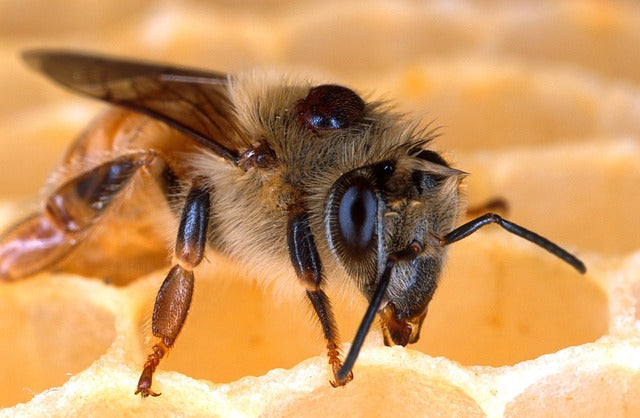
Adult female Varroa destructor mites can be identified by their oval shape and brown appearance
Why use Varroa mite treatments?
Bees are very important to humans because they pollinate plants, but varroa mite is increasingly becoming an ever-present pest of honeybee colonies across the UK.
Varroa mite (Varroa destructor) infestations within a hive above a certain level will harm a bee colony. Smaller and weaker bees unable to work as hard with shorter lifespans, more susceptible to disease and higher levels of viruses result in lower production and higher potential for colony collapse. Varroa mite is the number one management challenge for UK beekeepers.
The effects on a hive from varroa infestation depend on the level of infestation. Monitoring Varroa population is key to its management with varroa mite treatments used when a certain threshold is reached in order to support a healthy colony.
- Support healthy and productive colony
- Reduce disease transmission within a hive
- Increase colony survival
What is Varroa mite?
Varroa destructor (Acari: Varroidae) is a species of mite. It is an external parasite (ectoparasite) of honeybees (Apis spp.). Varroosis is the term used to describe the infection and subsequent disease development from the varroa parasite. Varroa feed and live on both adult bees and their brood. The mites feed on their host’s fat bodies reducing the condition of an individual bee and its ability to fully complete its role within the bee colony.
Female Varroa mites are easily recognised by their flat, reddish-brown oval bodies (1.5 x 1 mm). Male Varroa mites and immature female mites only exist within brood cells, and are smaller and pale in colour. Adult females carrying fertilized eggs are carried around the hive (or between hives) on adult bees. The females enter suitable brood cells before they are capped. As the bee egg develops they lay 5-6 eggs, the first being male, the following all being female. These hatch, feed on the bee larvae, mate and then females leave the cell carrying fertilized eggs when the host bee emerges in search of new brood cells to enter. The presence of a significant proportion of the life cycle protected within sealed brood cells is one of the challenges with Varroa management strategies.
Varroa destructor in the UK
The original host of the varroa parasite was the Asian honeybee (Apis cerana). The varroa mite was originally only located in Asia, but in recent years with increased international trade it has spread and is now present on four continents. Varroa destructor was first reported on continental Europe in the late 1970s. The first record in the UK was in 1992 located in Devon from where it has now spread across most of the UK. Its original host the Asian honeybee (Apis cerana) has some natural tolerance to its presence due to prolonged exposure and co-evolution. Western honeybees (Apis mellifera), as found in the UK, do not yet have this experience of prolonged exposure and therefore little natural defence or tolerance against it.
Varroa mite is now so widespread in the UK and is no longer a notifiable pest. Its management has now become a routine and essential part of bee husbandry.
What are Varroa mite treatments?
The entire life cycle of Varroa destructor mites occurs within the beehive. A significant portion of the life cycle occurs within the sealed brood cell which affects which and how varroa mite treatments are used. Andermatt offer a range of varroa treatment products fully approved by the Veterinary Medicines Directorate (VMD) for use in the UK. Which of these is most suited for use will depend on the time of year a treatment is to be carried out and Varroa population.
- Thymovar: Wafer strips containing Thymol for use after honey harvest. Discover more product information and where to buy here.
- Oxuvar: Liquid Oxalic acid can be diluted with either water for a spring spray application, or with sugar for a winter trickle application. Discover more product information and where to buy here.
How to use Varroa mite treatments in an Integrated Pest Management (IPM) program?
Integrated Pest Management (IPM) is the use of a combined approach to manage the risk of a pest within a production system. The fundamental aim of Varroa control is to keep the mite population below the level where it causes economic loss, therefore maintaining healthy colonies of bees for the production of honey and other hive products, and for pollination. The stages of IPM for varroa start at hive husbandry, include varroa monitoring followed by cultural control (e.g. physical management) through to varroacide treatment (e.g. Thymovar or Oxuvar).
Key to success of any IPM program is measuring the pest pressure. For Varroa mite there are a number of different methods to measure varroa population:
- counting dead mites which collect on the hive floor in a given time period (mite drop)
- counting mites inside sealed brood cells
- counting the number present on a sample of living bees
There are however, no universally agreed thresholds above which a Varroa population causes harm. A commonly used value is 1000 mites/colony during the beekeeping season.
When using varroacides to treat a colony or hive there is no single ideal time for treatment. The most suitable product to be used and time of treatment will vary depending on location, hive system, site history and varroa population.



